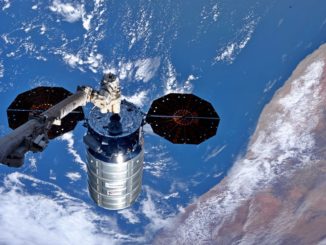
Crew members on the International Space Station over the weekend continued trying to pinpoint the location of a small air leak in the research outpost’s Russian Zvezda service module, one of the oldest sections of the orbiting laboratory.
As of Monday, the station crew had not located the precise site of the leak, but officials believe they have traced it to a transfer compartment at the rear section of the Zvezda module, near an aft docking port where a Russian Progress resupply freighter is attached.
Space station commander Chris Cassidy and his Russian crewmates Anatoly Ivanishin and Ivan Vagner have helped ground teams search for the source of the airlock for a couple of months. Ground controllers detected the leak in September 2019, and the station crew isolated themselves inside the Russian segment of the complex for a weekend in August to help track down where air is escaping.
Kenny Todd, deputy manager of the space station program at NASA, said Sept. 29 that mission control teams in Moscow and Houston detected several increases in the leak rate in recent weeks. But U.S. and Russian officials have stressed the leak is not a concern for the safety of the crew or the space station.
“The situation poses no danger to crew’s life and health, and doesn’t hinder the station’s continued crewed operation,” tweeted Roscosmos, the Russian space agency.
The faster leak rate made it easier to identify where the space station’s atmosphere is escaping, Todd said.
As of Sept. 29, Roscosmos said the leak rate was equivalent to about 1 millimeter of mercury, or 0.02 psi, every eight hours.

“We think, at this point, it’s in the Russian segment, the service module area,” Todd said. “Again, we’re continuing to look at all the data from the test but we do know and have confirmed with our Russian colleagues … that we think there’s something going on there.”
Cassidy, Ivanishin and Vagner have employed leak detectors scan window seals and other possible locations for the leak. Over the weekend, the Russian cosmonauts place plastic bags over possible leak sites to see if they deflated. When that turned up no sign that the leak was found, Russian mission control instructed the cosmonauts to tape seals on the Zvezda module’s aft docking port to see that those were the problem.
Despite the efforts, the leak was still present Monday.
The space station has spare air tanks that could be used to replenish the lab’s atmosphere. And there were two new high-pressure gas tanks on Northrop Grumman’s Cygnus supply ship that arrived at the space station Monday.
With the delivery of more gas tanks on the Cygnus spacecraft, Todd said the space station will “be OK out into the spring of next year,” assuming the leak rate remains unchanged.
“So this is not necessarily a near-term problem as long as the leak rate stays where it’s at today,” Todd said. “But if it were to get worse, obviously we’ll circle back up and revisit that.”

Space station managers are constantly reassessing the leak as ground teams prepare for a pair of critical crew launches later this month. The Russian Soyuz MS-17 spaceship is set for launch Oct. 14 from the Baikonur Cosmodrome in Kazakhstan with Russian commander Sergey Ryzhikov, flight engineer Sergey Kud-Sverchkov, and NASA astronaut Kate Rubins.
The Soyuz MS-14 crew will join Cassidy, Ivanishin and Vagner for a week-long handover, then Cassidy’s crew will depart the station and land in Kazakhstan aboard their Soyuz capsule.
Four more astronauts — Mike Hopkins, Victor Glover, Shannon Walker, and Soichi Noguchi — are scheduled to blast off Oct. 31 from the Kennedy Space Center in Florida on a SpaceX Crew Dragon spaceship, raising the station crew size to seven. It will be the first time a long-duration crew of seven has lived on the International Space Station.
“As we get closer to every one of our flights going to the International Space Station, if this problem continues, then we will constantly be looking at our consumables, be looking at our logistics train, and making sure that we can stay ahead of it,” Todd said.
Once the crew pinpoints the leak, engineers will examine ways to seal it up and fix the problem.
“But first and foremost, our goal is to find the leak,” Todd said. “When you look at a vehicle the size of the space station, it’s got valves hat go to vacuum, it’s got lots of different lines, plumbing, it’s got windows with seals. So there’s a lot of acreage with a lot of different leak paths that could be potential spots for us.”
But narrowing down the leak to the Zvezda service module, which launched in July 2000, helps engineers get closer to identifying its exact location, Todd said.
“Instead of a bunch of haystacks, we’re down to maybe just one haystack, but it’s still a needle we’re looking for.”
Email the author.
Follow Stephen Clark on Twitter: @StephenClark1.



